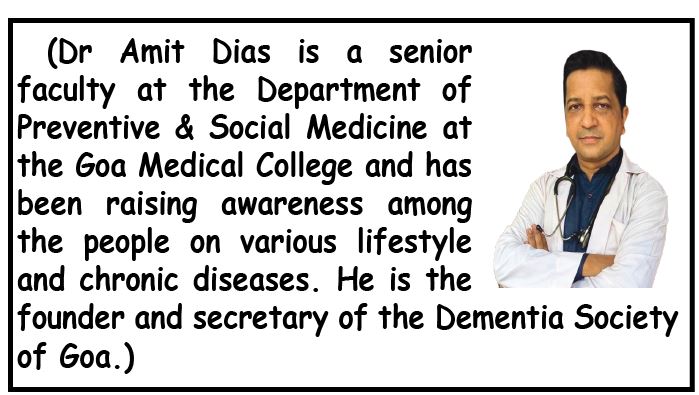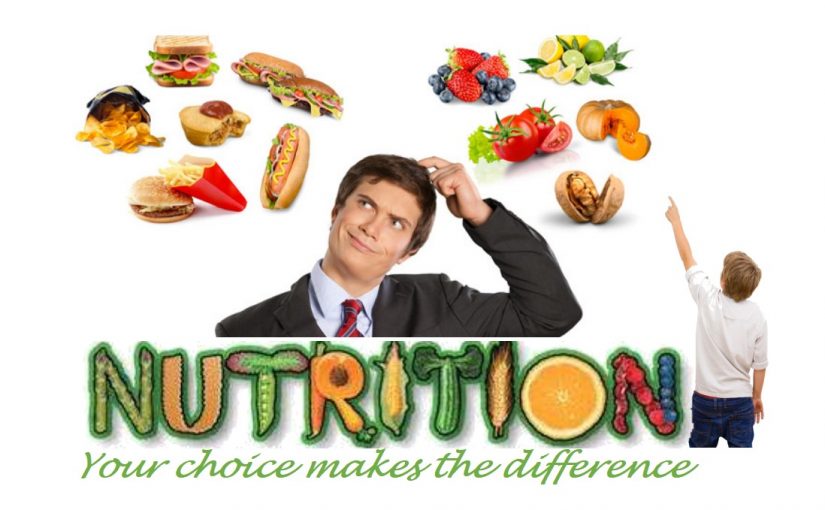Nutritious Diets for Everyone
A National Nutrition Week Special!
Come September and we enter Alzheimer’s Awareness Month. The first week of September is also observed as the “National Nutrition Week.” Is there a connection between malnutrition and Alzheimert’s disease? Dr Amit Dias says “Your choice makes the difference” and “Your diet could be the solution to various chronic diseases including heart disease, cancer, and Alzheimer’s disease.” Here is a fascinating interview on a topic that is very close to our heart!
A Q&A interview with DR AMIT DIAS
GOAN OBSERVER: Doctor, can you explain the importance of having a dedicated week for Nutrition Awareness?
DR AMIT DIAS: The National Nutrition Week is an essential initiative because it emphasizes the importance of nutrition in our daily lives. The theme this year is “Nutritious Diets for Everyone.” As a doctor I cannot emphasize enough the importance of a healthy diet in promoting health – the right food is literally your medicine and can cure and prevent many chronic diseases such as cancer, diabetes, hypertension, heart disease and even Alzheimer’s disease!
Good nutrition is the foundation of health and well-being, influencing physical, mental and emotional health. Unfortunately, many people are still unaware of what constitutes a balanced diet, the impact of poor nutrition, and the long-term consequences of unhealthy eating habits. By dedicating a week to nutrition awareness, we intend to build our appetite to learn more about nutrition, encourage healthy eating habits.
Q: Speaking of a “balanced diet” how would you explain this term in simple words?
A: A balanced diet is one that provides all the essential nutrients—carbohydrates, proteins, fats, vitamins, and minerals—in the right proportions to meet the body’s needs and also support in a period of leanness. It should include a variety of foods such as fruits, vegetables, whole grains, lean proteins and healthy fats. A balanced diet supports growth, repairs tissues, provides energy, and helps in preventing diseases. It’s not just about the quantity of food but also the quality and diversity, ensuring that all necessary nutrients are covered. Follow the food pyramid. Do not ignore the importance of fiber in the diet.
Q: Yes there is a lot spoken about fiber these days. Does it have a connection with Alzheimer’s disease as well? What’s its role in health?
A: Yes, fiber, which we get from whole grains, pulses, vegetables fruits, seeds such as almonds and chia seeds, etc, plays a crucial role in maintaining overall health, particularly our digestive health. It is a carbohydrate that the body cannot digest, meaning it passes through the digestive system relatively intact.
There are two main types of fiber: soluble and insoluble. Soluble fiber dissolves in water and can help lower blood cholesterol and glucose levels, while insoluble fiber adds bulk to the stool and helps food pass more quickly through the stomach and intestines.
Fiber is also essential for the health of the gut microbiome, which is the community of trillions of microorganisms living in the digestive tract. When fiber reaches the colon, it acts as a prebiotic, meaning it serves as food for beneficial gut bacteria. These bacteria ferment the fiber, producing short-chain fatty acids which is the protective ingredient and has multiple benefits.
Brain Health: It’s shown that nutrition has a role to play in the prevention of chronic diseases such as Alzheimer’s disease, in preventing the formation of beta amyloid plaques. Though there is no robust evidence as yet.
Prevention of Constipation: Fiber helps regulate bowel movements and prevent constipation by adding bulk to the stool. It can also reduce the risk of developing digestive conditions like irritable bowel syndrome (IBS) and diverticulitis.
Blood Sugar Control: Soluble fiber can slow down the absorption of sugar, helping to improve blood sugar levels, which is particularly beneficial for individuals with diabetes.
Heart Health: A diet high in fiber has been linked to a lower risk of heart disease. Fiber helps reduce levels of LDL cholesterol (the “bad” cholesterol) by binding to it in the digestive system and removing it from the body.
Weight Management: High-fiber foods tend to be more filling, which can help control appetite and reduce overall calorie intake, aiding in weight management.

Q: Could you tell us which foods are particularly good for brain and memory development? Are these different from foods that are good for heart health?
A: Foods that are beneficial for brain and memory development include those rich in omega-3 fatty acids, such as fatty fish (like salmon and mackerel), walnuts, and flax seeds. As I mentioned earlier, fiber also plays an important role in reducing gut inflammation and its consequences. These foods support cognitive function and help in the formation of healthy brain cells. Antioxidants, such as those found in blueberries, also support brain health by reducing oxidative stress.
While many brain-healthy foods are also good for heart health, there are some differences. For heart health, it’s crucial to focus on foods that reduce cholesterol and blood pressure, such as oats, avocados, nuts, and leafy greens.
However, the two are not mutually exclusive, and a diet rich in fruits, vegetables, whole grains and healthy fats generally supports both brain and heart health.
Q: The theme you mentioned is nutritious diets for all. Could you comment on the necessary nutrients in a child’s diet? What should parents focus on to ensure proper growth and development?
A: After the age of one year the child should get a balanced diet from the family food plate. Children’s diets should be rich in a variety of nutrients to support their rapid growth and development. Key components include protein for muscle and tissue growth, calcium and vitamin D for bone health, iron for cognitive development and healthy fats for brain development. Parents should focus on providing a colorful plate with fruits, vegetables, whole grains, dairy and lean proteins. You can find creative ways to serve veggies.
It’s also important to limit sugary snacks and beverages, encouraging healthy eating habits. This is not only true for children but for adults as well. We see so many adults who have strange food fads and avoid vegetables or fruits.
Q: Adolescence is another critical stage. What dietary changes should be made for adolescents?
A: Adolescence is a period of rapid physical and hormonal changes, requiring an increase in calorie intake and nutrients like calcium, iron, and protein. Iron is particularly important, especially for girls, to support the increased blood volume and to prevent anemia. Calcium and vitamin D are crucial for bone development, which peaks during adolescence. A diet rich in lean proteins, whole grains, fruits, and vegetables should be prioritized, along with adequate hydration and limiting junk food.
Q: How should the diet of pregnant and lactating mothers be adjusted?
A: Pregnant and lactating mothers have increased nutritional needs to support the growth and development of the baby and maintain their health. A diet rich in folic acid, iron, calcium, protein, and omega-3 fatty acids is essential. Folic acid helps prevent neural tube defects, iron supports increased blood volume, and calcium is crucial for the baby’s bone development. Omega-3 fatty acids aid in the baby’s brain development. It’s also important to stay hydrated and consume enough calories but from nutrient-dense foods rather than empty calories.
Q: What is the current burden of malnutrition in the world, particularly in India?
A: The global burden of malnutrition is substantial, with undernutrition and obesity being two sides of the same coin. According to recent reports, about 1.9 billion adults are overweight or obese globally, while 462 million are underweight.
In India, malnutrition remains a severe issue, with nearly 35% of children under five years old being stunted and 17% wasted. Obesity is also on the rise, particularly in urban areas. The double burden of malnutrition — undernutrition and obesity — poses a significant challenge to public health.
Q: Could you highlight some of the initiatives taken by the government of India to improve nutrition in our people’s daily eating habits?
A: The government of India has implemented several initiatives to address malnutrition. The Integrated Child Development Services (ICDS) program is one of the largest in the world, providing food, preschool education, and primary healthcare to children under six and their mothers. The Mid-Day Meal Scheme aims to improve the nutritional status of school-aged children by providing free lunches in schools.
Additionally, the National Food Security Act (NFSA) ensures access to subsidized food grains for the poor. These initiatives, along with targeted programs like Poshan Abhiyaan, aim to reduce malnutrition and improve the nutritional status of vulnerable populations.
Q: Which food items should people avoid to maintain good health, and why?
A: It’s crucial to avoid certain food items that can negatively impact health. Foods high in trans fats, such as some margarines, fried fast foods, and commercially baked goods, should be minimized because trans fats increase the risk of heart disease by raising bad cholesterol (LDL) and lowering good cholesterol (HDL). Processed foods often contain excessive amounts of sodium, sugar and unhealthy additives which can contribute to chronic diseases like hypertension, diabetes and obesity.
Food additives such as artificial colors, flavors and preservatives can also be harmful, particularly in large quantities. Some additives have been linked to allergic reactions, behavioral changes in children, and other health concerns.
Additionally, certain cooking processes, like deep frying or grilling at high temperatures, can produce toxins such as acrylamide, which is a potential carcinogen.
It’s also important to be cautious about food contamination from toxins like pesticides, heavy metals and chemical residues, which can have long-term health effects. We have not forgotten the formalin episode. Opting for organic produce and thoroughly washing fruits and vegetables can help reduce exposure to these harmful substances.
Q: How can we better understand the food labels on packaging to make healthier choices?
A: Reading food labels is an essential skill for making informed dietary choices. Start by looking at the serving size and the number of servings per container, as these numbers are crucial for understanding the nutritional information provided. The next step is to check the calories per serving, especially if you’re monitoring your calorie intake.
Pay close attention to the list of ingredients. Ingredients are listed in order of quantity, from highest to lowest, so if sugar or an unhealthy fat such as trans fats is near the top of the list, it’s best to avoid that product. Look for foods with whole ingredients like whole grains, nuts, and vegetables, and avoid those with a long list of artificial additives.
The nutritional information section provides details on the amount of fats, sugars, sodium, fiber and protein.

